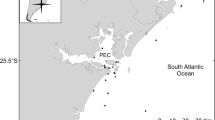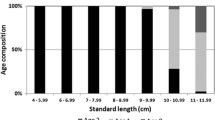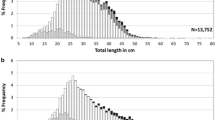Abstract
This study has determined the age and size compositions, growth rate and reproductive biology of Lepidogalaxias salamandroides using data for fish of known sex and age and the monthly trends exhibited by various gonadal variables, including the sizes and stages of the oocytes. The results resolve conflicting conclusions drawn by other workers concerning certain aspects of the biology of this freshwater species and expands our knowledge of this teleost. Our results are based on data derived from samples collected from small, ephemeral acidic pools in south-western Australia in 22 consecutive months. Although ca. 78% of the fish caught belonged to the 0+ age class, substantial numbers of the 1+ and 2+ age classes and some 3+ and 4+ fish were caught. Spawning occurs between late May and late August, with peak activity in late July and early August. During the first year of life, growth is initially rapid, but then ceases in the weeks immediately prior to and during the period when the habitat becomes dry and fish aestivate, before recommencing in autumn as the pools again become filled with water. The growth coefficient (K) in the von Bertalanffy growth equation was lower for females (0.63) than males (1.28), reflecting the greater growth undergone by females after the first year of life. Maturity was attained by ca. 28% of the females and ca. 26% of the males that reached the end of their first year of life and by all fish that reached the end of subsequent years of life. The L50s for females and males at first maturity were 43.2 and 38.6 mm TL, respectively. The mean fecundity was only 82.4, reflecting a combination of a small body size and a relatively large egg (diameter=1.8 mm). Lepidogalaxias salamandroides is a multiple spawner, which increases the chances of some eggs and newly-hatched embryos encountering a period of favourable environmental conditions during the spawning period, which is characterised by bouts of heavy rainfall. The ratio of females to males was essentially parity in the 0+ and 1+ age classes and in all age classes collectively. When testes commence maturing for the first time, the anal fin of males starts to become modified to form a structure that facilitates the transfer of sperm to the female, and it remains modified throughout the rest of life.
Similar content being viewed by others
References cited
Allen, G.R. & T.M. Berra. 1989. Life history aspects of theWest Australian salamanderfish, Lepidogalaxias salamandroides Mees. Rec. West. Aust. Mus. 14: 253-267.
Berra, T.M. & G.R. Allen. 1989. Burrowing, emergence, behaviour, and functional morphology of the Australian salamanderfish, Lepidogalaxias salamandroides. Fisheries 14: 2-10.
Berra, T.M. & G.R. Allen. 1991. Population structure and development of Lepidogalaxias salamandroides (Pisces: Salmoniformes) from Western Australia. Copeia 1991: 845-850.
Burt, A., D.L. Kramer, K. Nakatsuru & C. Spry. 1988. The tempo of reproduction in Hyphessobrycon pulchripinnis (Characidae), with a discussion on the biology of 'multiple spawning' in fishes. Env. Biol. Fish. 28: 15-27.
Gallucci, V.F. & T.J. Quinn. 1979. Reparameterizing, fitting and testing a simple growth model. Trans. Amer. Fish. Soc. 108: 14-25.
Gill, H.S. & D.L. Morgan. 1999. Larval development of the salamanderfish, Lepidogalaxias salamandroides Mees (Lepidogalaxiidae). Copeia 1999: 219-224.
Laevastu, T. 1965. Manual of methods in fisheries biology. FAO, Rome. 51 pp.
Leung, L.K.-P. 1988. Ultrastructure of the spermatozoan of Lepidogalaxias salamandroides and its phylogenetic significance. Gamete Research 19: 41-49.
McDowall, R.M. 1998. Salmons and their allies. pp. 113-118. In: J.R. Paxton & W.N. Eschmeyer (ed.) Encyclopedia of Fishes, Academic Press, San Diego.
McDowall, R.M. & B.J. Pusey. 1983. Lepidogalaxias salamandroides Mees-a redescription, with natural history notes. Rec. West. Aust. Mus. 11: 11-23.
Morgan, D.L., H.S. Gill & I.C. Potter. 1995. Life cycle, growth and diet of Balston's pygmy perch in its natural habitat of acidic pools. J. Fish Biol. 47: 808-825.
Morgan, D.L., H.S. Gill & I.C. Potter. 1998. Distribution, identification and biology of freshwater fishes in south-western Australia. Rec. West. Aust. Mus. Supplement No. 56, Perth. 97 pp.
Pen, L.J., H.S. Gill, I.C. Potter & P. Humphries. 1993. Growth, age composition, reproductive biology and diet of the black-stripe minnow Galaxiella nigrostriata (Shipway), including comparisons with the other two Galaxiella species. J. Fish Biol. 43: 847-863.
Pen, L.J. & I.C. Potter. 1990. Biology of the nightfish, Bostockia porosa Castelnau, in south-western Australia. Aust. J. Mar. Freshwat. Res. 41: 627-645.
Pen, L.J. & I.C. Potter. 1991a. Biology of the western minnow, Galaxias occidentalis Ogilby (Teleostei: Galaxiidae), in a south-western Australian river. 2. Size and age composition, growth and diet. Hydrobiologia 211: 89-100.
Pen, L.J. & I.C. Potter. 1991b. The biology of the western pygmy perch, Edelia vittata, and comparisons with two other teleost species endemic to south-western Australia. Env. Biol. Fish. 31: 365-380.
Pen, L.J. & I.C. Potter. 1991c. Biology of the western minnow, Galaxias occidentalis Ogilby (Teleostei: Galaxiidae), in a south-western Australian river. 1. Reproductive biology. Hydrobiologia 211: 77-88.
Pen, L.J., I.C. Potter & R.W. Hilliard. 1991. Biology of Galaxiella munda McDowall (Teleostei: Galaxiidae), including a comparison of the reproductive strategies of this and three other local species. J. Fish Biol. 39: 717-731.
Pusey, B.J. 1989. Aestivation in the teleost fish Lepidogalaxias salamandroides Mees. Comp. Biochem. Physiol. 92A: 137-138.
Pusey, B.J. 1990. Seasonality, aestivation and the life history of the salamanderfish Lepidogalaxias salamandroides (Pisces: Lepidogalaxiidae). Env. Biol. Fish. 29: 15-26.
Pusey, B.J. & S.D. Bradshaw. 1996. Diet and dietary overlap in fishes of temporary waters of southwestern Australia. Ecol. Freshwat. Fish 5: 183-194.
Pusey, B.J. & D.H. Edward. 1990. Limnology of the southern acid peat flats, south-western Australia. J. Roy. Soc.West. Aust. 73: 29-46.
Pusey, B.J. & T. Stewart. 1989. Internal fertilization in Lepidogalaxias salamandroides Mees (Pisces: Lepidogalaxiidae). Zool. J. Linn. Soc. 97: 69-79.
Saila, S.B., C.W. Recksieck & M.H. Prager. 1988. Basic fishery science programs: a compendium of microcomputer programs and manual of operation. Elsevier, Amsterdam. 230 pp.
Author information
Authors and Affiliations
Rights and permissions
About this article
Cite this article
Morgan, D.L., Gill, H.S. & Potter, I.C. Age Composition, Growth and Reproductive Biology of the Salamanderfish Lepidogalaxias salamandroides: A Re-examination. Environmental Biology of Fishes 57, 191–204 (2000). https://doi.org/10.1023/A:1007652714404
Issue Date:
DOI: https://doi.org/10.1023/A:1007652714404




